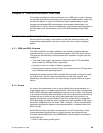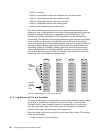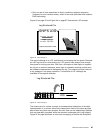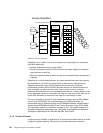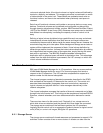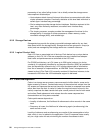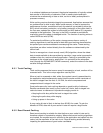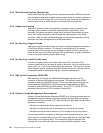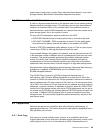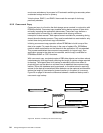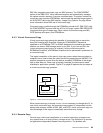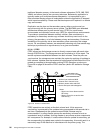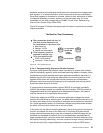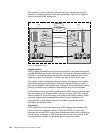Disk Environment Overview 91
In a relational database environment, the physical separation of logically related
data results in little locality of reference. Data in memory techniques also
minimize the re-referencing of data on disk, as this is ideally accomplished in
processor memory.
Write caching requires that data integrity be preserved. Applications assume that
an update written to disk is safe. When cache memory is used to improve the
performance of writes, an additional level of protection is provided by either the
NVS, which has battery protection, or by battery protection of the cache itself. In
the first case, updates are written to both cache and NVS before I/O is signaled
complete to the application. The copy in the NVS is marked as available for
overwriting once the update is destaged to disk. The function of caching writes is
called
DASD fast write (DFW).
To maximize the efficiency of the cache, storage servers have a variety of
caching algorithms to use the cache for data with good caching characteristics,
but prevent poor cache candidates from swamping the cache. These caching
algorithms are either invoked directly from the software or determined by the
server itself.
Cache is managed on a
least recently used (LRU) algorithm, where the oldest
data is made available to be overwritten by new data. Large cache improves the
residence time for a cache-unfriendly application. Caching is controlled by the
hardware at the volume level or extent level. It is controlled at the subsystem
level (through the IDCAMS SETCACHE command), and at the volume or the data
set level through software.
9.3.1 Track Caching
Track caching assumes that once a record is accessed on a track, another will be
accessed soon. This is the unique algorithm used by RVA.
When a track is accessed on disk, either the required record is passed back to
the application and simultaneously copied into the cache and the remainder of
the track is staged from the disk, or, for RVA, the whole compressed and
compacted track is staged in the cache.
Good performance for track caching depends on good locality of reference.
Random workloads often result in poor cache hits, that is, data is staged into
cache but never re-referenced. Unproductive staging results in:
• Keeping the disk busy while the track is staged into cache
• Keeping the paths busy while staging
• Using up space in the cache
A poor cache hit rate is likely to be less than 50-60% for reads. To gain the
benefits of DFW, data with a poor cache hit rate will require a large cache.
9.3.2 Read Record Caching
Read record caching is suitable for data that has a poor cache hit rate and is
therefore subject to unproductive staging. Where read record caching algorithms
are invoked, the required record is returned to the application and copied into the
cache, but the remainder of the track is not. Record caching avoids adversely
impacting the performance of good cache candidates.





